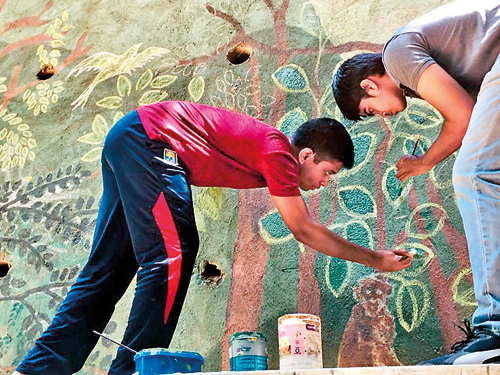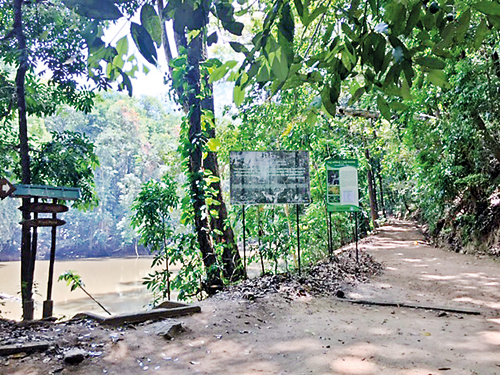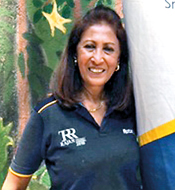Take a walk through the lungs of Kandy, Udawattekele
“When the first Indo-Aryan settlers of the Island did ascend the lower hills of the highlands and stumbled on the lush, well watered valleys and began establishing settlements there, Udawattekale came to be the starting point from where the ancient village of Senkadagala arose, the Asgiri Upatha states.” (Nihal Karunaratne, Udawattekale – The Forbidden Forest of the Kings of Kandy).

Students painting the mural
Centuries ago, Udawattekele was a thick rain forest of thousands of acres where elephants, elk and leopard roamed. The first human settlement of Senkadagala was founded in the reign of Gajabahu of Anuradhapura who ruled from 114 – 136 A.D.
King Wickremabahu established his kingdom in 1371 and named it Senkadagalapura in memory of the Brahmin Senkanda who lived in a rock cave in Udawattekele. Thereafter, all the kings who ruled in Kandy, as Senkadagala came to be known, considered the forest a part of the palace and conserved it as a ‘Tahansi Kale’ - a forbidden forest for the public. It was also known as the Uda Wasala Watte (the garden above the royal palace) and was the exclusive pleasure garden of the royal family. The queens bathed in the pond where legend has it that a golden pot filled with King Kirthi Sri Rajasinha’s treasures is buried. Also, that a golden sembuwa (pot) is seen floating on the surface once a year. Another legend is that a tunnel connects the pond with the Kandy lake.
In British times, Governor Horton constructed the first path through the forest, naming it Lady Horton’s Walk. By the side of the pond is the Lovers’ Walk and many other paths of which Lady Gordon’s Drive is popular among bird watchers. Major roads were constructed by Governor Sir Edward Barnes – for military and commercial purposes through the forest.
Later, the British themselves realized the value of Udawattekele and declared it a reserved forest in 1856. In 1885 the Forest Act became law and in 1887 the Forest Department was set up but it took a further five years to proclaim Udawattekele a Forest Reserve.

Udawattekele; pond and leafy paths
Udawattekele today is a haven of peace and solitude, a mere ten minute walk from the Sri Dalada Maligawa. The forest supports the ecological balance of the highly air polluted city, giving it the much needed oxygen for its fast increasing population. Small streams of water flow from the forest catchment areas to the Kandy lake and the paddy fields of Lewella, Katugastota and the surrounding areas of the city.
In 1976, a committee headed by the Government Agent of Kandy was formed for the development of Udawattekele and agreed on the gigantic task of fencing the forest. Dr. Nihal Karunaratne, an active member of the committee suggested a shramadana on consecutive Saturday mornings. Schoolchildren helped in erecting fence posts with a thousand school cadets planting cordia plants along the boundary of the Aruppola-Lewella section of the forest. Some prisoners also helped in de-silting the Udawattakele lake.
When the Sunday Times visited recently, Avanti Sri Nissanka-Karunaratne with a group of youngsters was painting the concrete parapet wall of the Tapowana Temple at the entrance to the Udawattekele forest Reserve. The incumbent monk Ven. Tapowané Sangwara Thera had given permission to paint the wall on condition that it should blend with the surrounding environs. Avanti, Director Youth Service (2019-2022), Rotary Club Kandy, had suggested they make it a joint project with all the Interact and Rotaract clubs.

Avanti Sri Nissanka-Karunaratne
“I chose colours which would be in harmony with the forest,” Avanti says adding that small deer and monkeys would come to watch them at work. The vast mural, 64’ x 20’ now completed is the work of students from the Interact clubs of 20 schools and two Rotaract Clubs of the Kandy Rotary Club.
The Extension Officer of the Forest Department tells us that at present 257 acres have been secured as the Udawattekele Forest Reserve. The forest is in an intermediate climate zone having both wet and dry zone species. It has about 400 species of plants, which includes herbs, ferns and orchids, he says.
Fifteen different mammals, over 80 species of birds, 32 species of butterflies and several varieties of reptiles and amphibians are recorded here. Barking Deer, wild boar, spotted deer, porcupine, Hambewa - flying squirrel, Kaballewa (pangolin), water monitor, squirrels, lizards, civet cats and many more are seen. Large troops of monkeys frequent the tree tops.
Two hermitages are found in Udawattekele – the German Temple and the Senanayake Aramaya. The most famous rock cave is the Senkanda Brahmin’s cave to which, until recently, there was easy access. But when this writer visited, it was covered due to an earthslip and has still not been cleared.
There is also a trekking ridge that ascends to 550 metres, the forest’s highest point, also known as kodimalé (flag point) where in days of yore, kings had hoisted the national flag.
Enjoy a walk through Udawattakele the next time you visit Kandy – a priceless heritage that should be preserved for future generations.
Searching for an ideal partner? Find your soul mate on Hitad.lk, Sri Lanka's favourite marriage proposals page. With Hitad.lk matrimonial advertisements you have access to thousands of ads from potential suitors who are looking for someone just like you.


